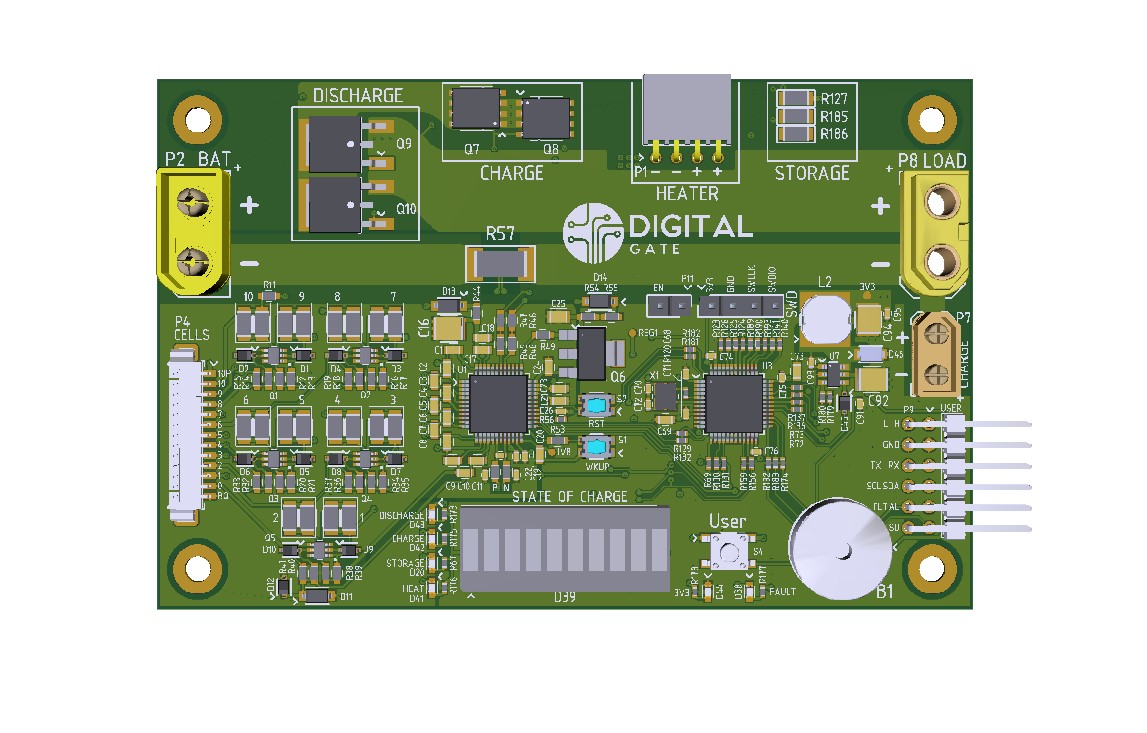Digital Gate is excited to introduce you to one of our flagship products: an efficient and secure Battery Management System (BMS), meticulously designed and implemented by our expert team. Join us as we delve into the intricacies of this innovative solution, poised to redefine the landscape of energy management.
First let’s go through the basics of a BMS:
What is a BMS and why is it important?
A battery management system (BMS) is the brain of a battery pack. The BMS is a set of electronics that monitors and manages all of the battery’s performance. Most importantly, it keeps the battery from operating outside of its safety margins.
The battery management system is critical to the battery’s safe operation, overall performance, and longevity. Moreover, it protects whatever the lithium battery is installed in and the people who are using it.
Battery management systems are critical in protecting the battery’s health and longevity but even more important from a safety perspective. The liquid electrolyte in lithium-ion batteries is highly flammable.
So, these batteries need to be always operating optimally and within safety limits to prevent a fire.
Protections Offered by a Battery management System:
• Under and Over-Voltage
• Temperature Extremes
• Protections from shorts
• Over-discharge
• Overcharge
• Overcurrent protection
Application of Smart BMS by industry:
• Electric Vehicle (EVs): A BMS in EVs monitors battery health, manages charging and discharging processes, and ensures safety during operation.
• Renewable Energy: Solar power, wind farms, and other renewable energy systems often use batteries to store energy for later use.
• Consumer electronics: Devices like smartphones, laptops, tablets, and wearable technology use rechargeable batteries.
• Telecommunications: Cell towers, base stations, and communication networks rely on backup battery systems for uninterrupted power supply during outages.
• Energy Storage Systems (ESS): Large-scale energy storage systems, such as those used in grid stabilization and peak shaving applications, require sophisticated BMS to manage battery arrays effectively.
• Maritime and Offshore Industry: Ships, offshore platforms, and marine vessels increasingly use battery systems for propulsion and auxiliary power.
• Aerospace: Aircraft and spacecraft use batteries for various applications, including emergency power and auxiliary systems.
• Medical Devices: Equipment such as portable medical devices, patient monitors, and diagnostic tools rely on rechargeable batteries.
• Military and Defense: Military vehicles, communication systems, and equipment often utilize rechargeable batteries.
• Unmanned Aerial Vehicles (UAVs) and Drones: UAVs and drones use batteries for propulsion and onboard systems.
Challenges Facing the Battery Management System Market
- Cost: The expense of BMS systems can pose a significant hurdle to their widespread adoption, particularly for smaller manufacturers and niche applications. These systems rely on sophisticated electronics and sensors, driving up the overall cost of battery systems.
- Complexity: BMS systems are inherently complex, necessitating advanced software algorithms and hardware components for monitoring and managing battery performance. This complexity presents obstacles in designing and manufacturing reliable and efficient BMS systems.
- Safety: Safety stands as a paramount concern within the battery industry, with BMS systems playing a pivotal role in ensuring the safety of battery systems. Nevertheless, crafting a BMS system capable of effectively mitigating the risks associated with battery systems presents a considerable challenge.
- Compatibility: BMS systems must align with specific battery chemistries and designs, posing challenges for manufacturers tasked with developing different BMS systems tailored to various battery types.
- Performance: BMS systems must strike a delicate balance between optimizing battery performance and efficiency while safeguarding the safety and longevity of the battery system. Designing a BMS system capable of achieving this balance proves to be a formidable challenge.
In facing these challenges, Digital Gate emerges as the ideal partner to ease concerns and simplify decision-making. With our comprehensive development services spanning device drivers, frameworks, bootloaders, and complete infrastructure solutions, we empower clients to navigate the complexities of BMS implementation effortlessly. Our transparent development process ensures meticulous execution at every stage, alleviating worries surrounding safety, compatibility, and performance. By choosing Digital Gate, you're not just selecting a provider; you're embracing a transformative partnership that streamlines the journey towards efficient and reliable BMS integration, allowing you to focus on your core objectives with confidence and ease.
How does our BMS design work?
In crafting our Battery Management System (BMS), we have leveraged the widespread popularity of Lithium Polymer (LiPo) batteries as the cornerstone of our design. This decision stems from their extensive market penetration and favorable characteristics, including high-capacity density, robust discharge capabilities, and minimal leakage currents. While LiPo batteries offer compelling advantages for a multitude of applications, their utilization necessitates careful attention to safety protocols. Our pioneering solution not only addresses these safety considerations comprehensively but also aims to optimize the longevity and versatility of the batteries across diverse environmental conditions.
Our smart BMS is based on:
• 10S LiPo battery pack with capacity of 5000mA/h
• BMS IC BQ7694202 from Texas Instruments
• MCU STM32F072CBT6 from ST
• Battey charger LT8490 from Analog Devices

Figure 1 – Block diagram of our smart BMS
How is the Battery pack connected?
The battery pack is comprised of a configuration featuring ten Lithium Polymer (LiPo) battery cells interconnected via a bespoke "United PCB" assembly. This specialized circuitry facilitates both soldering and welding of battery leads, ensuring optimal current density for discharge operations. Such an approach not only streamlines the connection process but also enhances reliability. Furthermore, the United PCB incorporates a dedicated connector outfitted with voltage monitoring capabilities for each individual cell, facilitating effortless measurement and effective balancing procedures.
Additionally, the versatility of the assembly extends to the integration of custom heaters within the battery pack, thereby ensuring safe and efficient operation even in challenging cold environments.
Our solution for cold environments
Our innovative solution offers a robust mechanism for harnessing battery power even in the most challenging sub-zero environments. This capability is crucial given the inherent limitations of utilizing Lithium Polymer (LiPo) batteries in cold conditions, where their performance can be severely compromised, leading to potential damage and safety hazards such as fire outbreaks. Maintaining battery temperatures above freezing point during discharge operations is imperative, hence our incorporation of specialized heaters strategically positioned between battery units. These heaters, seamlessly integrated into the Battery Management System (BMS) framework, boast an impressive heat dissipation capacity of up to 65W. Operating within a compact Printed Circuit Board (PCB) form factor, they feature intricate spiral-type trace configurations, effectively functioning as distributed heating resistors across the battery array. This meticulous design approach ensures uniform heating throughout, thus not only safeguarding battery integrity but also extending their operational lifespan significantly.

Figure 2 - Compact PCB form factor functioning as heating resistors across the battery array
Our BMS design
The foundation of our BMS board lies in the sophisticated BQ7694202 IC developed by Texas Instruments. This integrated circuit offers an expansive array of configurable parameters, affording unparalleled flexibility in tailoring the system to meet diverse custom requirements. Facilitating seamless parameter configuration is TI's intuitive software interface, complemented by their interface adapter, streamlining the setup process and saving significant time and resources during the crucial R&D phase.
Our meticulously designed PCB is equipped to monitor all parameters essential for battery safety, encompassing voltages, currents, and temperatures. To fortify protective measures, our solution integrates MOSFET transistors primed to sever the current path upon activation of alarm triggers. Additionally, our design incorporates parallel paths for both charge and discharge currents, optimizing efficiency by enabling the downsizing of transistor packages and maximizing PCB utilization.
Facilitating seamless integration with the main control system, our BMS features both CAN and UART interfaces, enabling bidirectional communication for data retrieval and system control as needed.
Key features of our BMS include:
• Automatic battery balancing during charging prolongs the lifespan of the battery pack.
• Customizable heating functionality to facilitate operation in frigid environments.
• Support for battery discharge for entering in Storage mode.
• Audible alarms for prompt notification of critical events.
• Visual indicators providing real-time feedback on state of charge and operational modes.
• Versatile UART and CAN interfaces for robust communication capabilities.

Figure 3 - Battery Management System Base Printed Circuit Board
Our efficient solution for charging
Together with our Battery Management System, we have developed a bespoke battery charger utilizing the LT8490 IC from Analog Devices. This advanced charger boasts versatile charging capabilities encompassing Constant Current (CC), Constant Voltage (CV), and trickle modes, ensuring optimal battery replenishment. Operating across a broad input voltage range spanning from 24V to 48V, the charger offers adaptability to diverse power sources. Moreover, its parameters can be finely tuned to accommodate specific custom requirements, including charging current, battery voltage, input voltage, and various protection protocols.
Key Features of the Charger:
• Wide input voltage range of 24V to 48V, accommodating a variety of power sources.
• Utilization of Buck-Boost mode for enhanced charging efficiency across varying input voltages.
• Adjustable charge current up to 1A.
• Implementation of reverse polarity protection, safeguarding against potential damage due to incorrect connection.
• Real-time monitoring of charger status via UART Rx interface, enabling comprehensive system oversight.
• Provision of fault output signal for prompt detection and response to charging anomalies.
• Support for shut-down input signal, facilitating seamless integration into broader system architectures.

Figure 4 - Advanced charger with versatile charging capabilities
Conclusion
In essence, the Battery Management System (BMS) plays a pivotal role in optimizing the performance, safety, and longevity of battery systems. By meticulously monitoring and controlling key parameters such as voltage, current, and temperature, the BMS ensures efficient energy utilization and safeguards against potential safety hazards. Ultimately, the BMS is indispensable in maximizing the reliability and lifespan of batteries, thereby enhancing the overall efficiency and functionality of numerous electronic devices and systems.

